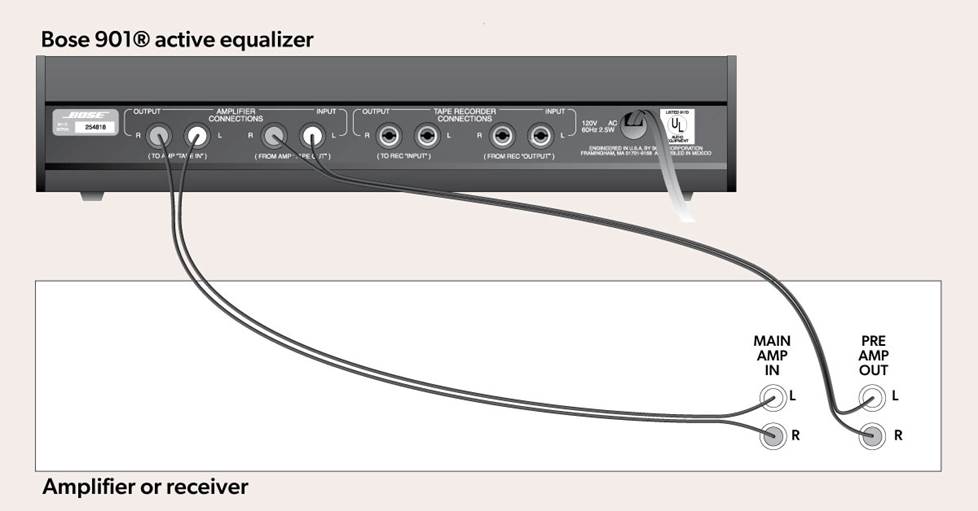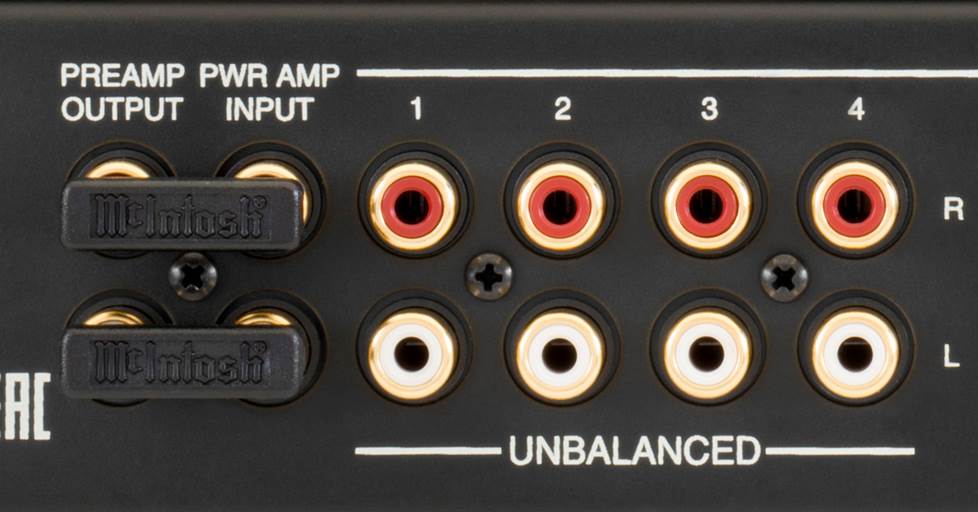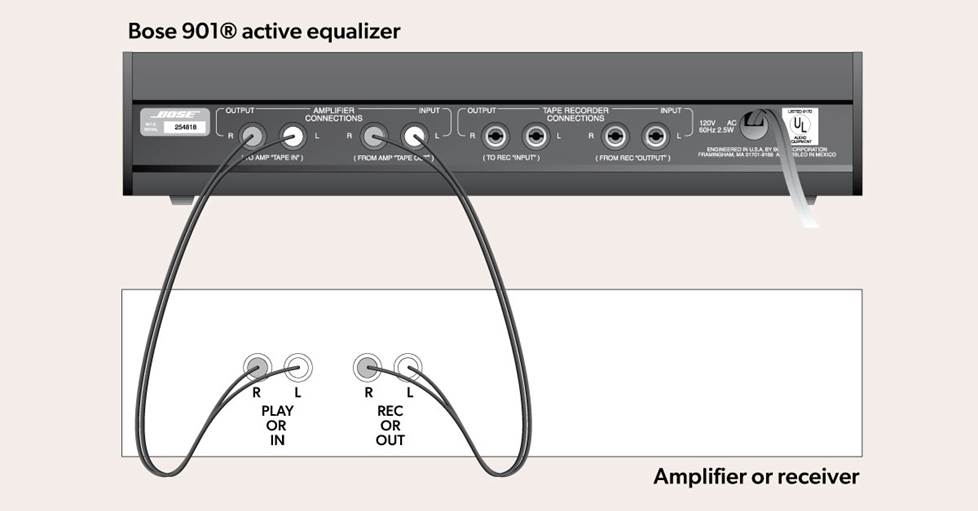Actually, somebody in my college dorm had a pair of 901's that he'd placed facing backwards, firing the front against a wall. This was around 1972, so I can't remember much about them besides that!
Bose 901 Series V Questions
Please no Bose bashers.
#1. Has anyone ever listened to these speakers backwards ?
( with the 8 woofers facing you )...interested in your opinion regarding sound ...good or bad ?
#2. Can the color of the drivers be black as well as blue ?
I am running my Bose Equalizer between Amp and Preamp...Is that a good way ?
Thank you
Here ya go! Three ways to connect the Bose 901 EQ to your stereo systemIt’s a good time to be a Bose 901 owner, as there are many solid choices for amplification that make it easy to integrate the 901’s equalizer. This wasn’t the case just a few years ago, when it seemed like no home electronics had the capability to integrate with the Bose 901 system, unless you went with a separate preamp and amplifier combination. They were practically unusable with most integrated amps, stereo receivers, and of course, home theater receivers. So, you have a pair of Bose 901 speakers, and you have the equalizer they came with. Here’s what you need to use them: The Bose equalizer has a pair of analog RCA inputs, and a matching pair of outputs. You need to connect a pre-amplified signal to the inputs, the Bose EQ does its thing, then the outputs go to your amplifier. Once amplified, your music is sent to the speakers through speaker wires. Connect to a separate preamp and amplifierThe most straightforward way to make the connections described above is to use separate components. You’ll need a stereo preamp and a stereo amplifier, two sets of RCA cables and some speaker wire. You can see how this works in the diagram below.
Connecting the Bose 901 EQ to a separate amp and preamp lets you customize your sound system. But it also means you need space for three different components. One benefit of using separate components is that you can mix and match different amps and preamps to achieve the sound you want. And you can also replace one or the other if you want to upgrade, or if one of them goes bad. Connect to a single stereo componentUsing separates isn't super common these days as many people prefer a more integrated system. This can come in the form of an integrated amp or a stereo receiver. Both of these options include the preamp section and the amplifier in one component. Using an integrated amp or stereo receiver built to a high standard is a great way to condense your stereo system without sacrificing sound quality. If you were using an average set of speakers (not the Bose 901s), you'd simply connect them to the amplified, speaker-level outputs of your integrated amp or stereo receiver. However, if you want to use the Bose 901 speakers and equalizer, you’ll need an integrated amp or stereo receiver with a special set of variable analog RCA preamp outputs AND a set of analog RCA inputs that go straight to the amplifier. These connections let you hook the Bose 901 EQ up in-line between the preamp and amp, even though the preamp and amp are in the same box. There are two connection combos that make it possible to use the Bose 901 EQ with a single stereo component: a tape monitor loop, or a pre-out/main-in loop. Many of today’s integrated amps have the pre-out/main-in loop. The tape monitor loop is no longer very common, because, you know…tapes. I'll explain both below. Pre-out/Main-in loop connectionsSome components have pre-out/main-in loop connections specifically for hooking up a separate EQ. Back in the '70s, equalizers were commonly used in higher end home audio systems. An EQ could make analog sources (like tapes and vinyl) sound better. And it could also fix problems with the sound of the room that the system was in. Today we no longer use separate EQs, thanks to most sources being digital, sophisticated signal processing, and room correction software.
It's possible to connect the Bose 901 EQ to a single stereo component with pre-out/main-in loop connections. The pre-out sends whatever source is being played to an outboard EQ, like the one included with the Bose 901s, using stereo RCA cables. The main-in part of the loop receives the music as it comes back from the EQ and sends it on to the amplifier section of the component.
Stereo components with pre-out/main-in loop connections often come with jumpers that connect the pre-out to the main-in when no EQ is going to be used. These jumpers are removed if an EQ is used. Tape monitor loop connectionsA tape monitor loop works in a similar way. In fact, the connection requirements are identical. However, a tape monitor loop functions slightly differently than a pre-out/main-in loop. A tape monitor loop, as the name implies, allows you to monitor a recording, live, in real time. Say, for example, you were recording a record from your turntable to a cassette so you could play the cassette in your car. The tape monitor loop would allow you to listen to the tape as it’s being recorded onto rather than listening to the record as it’s being played. This is simply not needed with today’s digital solutions for recording vinyl onto a more portable digital medium. However, if you have an older integrated amp or stereo receiver with a tape monitor loop, your connections for the Bose 901 speakers and EQ would look like this:
You can connect the Bose 901 EQ to an older stereo component with tape monitor loop connections. When Bose stopped manufacturing the 901 speaker system, the number of integrated amps and stereo receivers with compatible connections dwindled down to almost nothing. But many manufacturers have begun to add those pre-out/main-in loops back onto their integrated amps. Stereo receivers, not so much. So, if you are looking to use a Bose 901 speaker system with modern electronics, you’ll want to look for a separate stereo preamp and amplifier combination that suits all your other audio needs, OR an integrated amp with a pre-out/main-in loop that does not exceed the maximum RMS power handling for your series of Bose 901 speakers. |
+1 @yogiboy Awesome writeup and spot on. Back in the early 80’s, I ran my 901 equilizer and dbx 3bx range expander through the signal processing loops in my SoundCrafsman SP4001 equalizer/pre amp. Those were the days. I had the original 901’s with the chrome stands. I would sometimes turn mine around for direct sound when we partied like it was 1999. But most of the time I played them in the reflex position. I also found they sounded like crap without the Bose equalizer. |
Don’t run them backwards; they were engineered more carefully than given credit. The walls and placement make the difference between amazing and gawd awful. You either have the right room or you don’t. Use the supplied equalizer; again, tied more closely to the drivers and enclosure than folks realize. Don’t be fooled by the simplicity of everything. Last, separates give the best opportunity to make them shine. They love power…I’m running mine with 650wpc mono blocks. The head room really lets them perform. |
The best sound I got from 901s was in front of a brick wall. With the V towards the wall. That wall had a surprisingly large impact on the sound. And breathing space. The V maybe three-four feet in front. And of course, most of the time I did use the equalizer. But I never liked the sound of it. This was the v2 version. I thought of getting a better equalizer but never got around to it. |
I once watched a movie, or maybe it was one of those CSI shows on the TV, in which the crime scene room had a pair of Bose 901 speakers with the "V" pointed out into the room. I could understand the prop man making that mistake as that’s the side that houses most of the drivers. Back in the ’70’s I bought a used set without an equalizer and they sounded pretty bad. I bought a second set and wired them in parallel, one set on their stands and the other hanging a couple of feet from the ceiling directly above the first set and powered by a Phase Linear 700B. I thought I had attained the "absolute sound"! |
I have a pair of 901 IV's in a secondary system in my screen porch (the rears pointed at solid walls). I bought them cheap as the equalizer had been lost. The only music that sounded good on them was dub. I tried Nick Drake- terrible is too kind a word for the result! I bought an equalizer online- now all's fine. I have Quads in my living room, which are much better for close listening. 901's do what they're engineered to do very well- they move a huge amount of air for their size, filling the room with very spacious sound, making all recordings sound "big". They don't open a window into the inner life of the music- it's more like they demand you wallow in the gestalt of it all. Check your critical faculties at the door, partake in psychoactive substances if that's your thing, feed the system loud, impactful material & you'll be in heaven until the neighbors complain! They make me feel like a teenager again, which has its pluses and minuses. |
The 901’s are very picky on how they need to be placed. Distance from the ceiling, side walls, rear walls, from each other etc. As far as your question is concerned, yes, you can turn them around but the room filling effect that they were designed for goes out the window. If you can’t install them within the parameters suggested by the manufacture, having them backwards may even be a better option. I have heard them backwards and they sound good. Just experiment. If you like the way they sound that’s all that matters. As for me, I was happy with them when I had them, but over time realized that they lack fidelity. I donated them to a family member several years ago. * Definitely use the included eq! |
I've had several pairs of 901s of different vintage. If setup exactly to Bose specs the wall that the 8 drivers face needs to an empty space as well as the adjoining walls for at least the first reflection point. Yes the Bose equalizer is a sore spot. And massive power helps (that's what they like). I have a pair of 901 Series VI right now in my second system which is in the garage playing backward. They sound really good (for what they are) considering my garage is all concrete and 1000 square feet. They are sitting on typical crappy steel shelving (Lowes, Home Dopey) about eight apart. Quite a bit of bass that way as proximity to the ceiling seems to create coupling. Interesting that everyone, including audiophiles, just kinda shake their heads because they go far past what they were expecting. Of course being driven by a tubed ARC preamp and ARC SS amp doesn't hurt. So, yes you can run them backward to good effect. Regards, barts |
I had and liked a pair of 901's from 1972 til 199?..when the 500W Bose amp shorted for a second time, taking out one of it's channels and frying all the drivers on that side. Replaced with Vandersteen 2ci's. I use the remaining speaker for my back surround in normal v to the wall, to spread the sound as intended...use the HT AV amp room correction to replace the equalizer. Works great but of course there's only occasional sounds coming from the back channel. (surround music CD's/DVDs are fun). |
I’ve had my 901’s for many years now, and still enjoy them. But recently I swapped out the equalizers (I have two pair) for equalizers from Deer Creek Audio, and WOW! I’m hearing details I’ve never heard before. (A new preamp also undoubtedly helps). I listen to both music and movies/tv, and as part of a home theater setup, they work great. |
I got to be on a first name basis with the apartment manager and a few of the local constabulary with introductions handled by a pair of 901's. They were hung from the ceiling in the reflex position. As I recall the Bose pre ran through an SAE 2100L and then into A Stereophon amp, and then into a Phase Linear after the Stereophon blew. I think listening to Led Zeppelin through a pair of 901's at 11 should be on everyone's bucket list. BTW, I thoroughly enjoyed my 501's for years, and I wish I had them back. |
| Post removed |
@mbarrett635 - new equalizer - this is probably what I should have done. But in the end I wanted something new anyway. Great speakers but they did have limits. |
Heads up for anyone wanting their 901's repaired, as of May 31 2024 Bose will no longer support repair of this product. As of today we have enough drivers to complete one more set of speakers with the black V2 drivers. We only have 16 of the blue cones. Personally I think this is the one product they should have supported till the end of Bose. |





